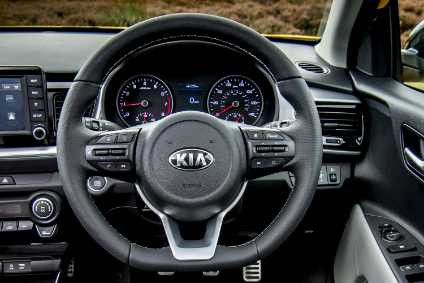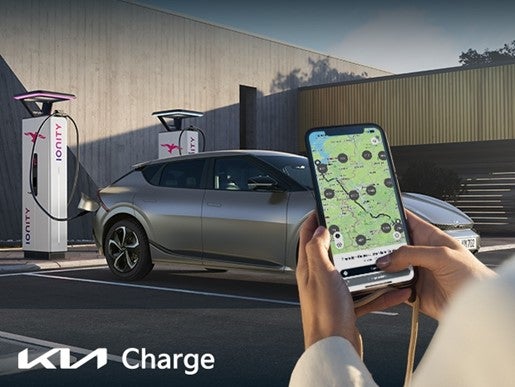
Arriving late to the party, the Kia Stonic is the South Korean carmaker's first entry into the crowded small (B-segment) SUV market. Continuing QUBE/just-auto's review of interior design and technology trends, we slip inside the top-drawer First Edition trimmed model to take a closer look.
Stonic is a European-Korean design effort; most of the design work was completed at Kia's European design centre in Frankfurt with assistance from Namyang. It is based on the Rio platform and built alongside it in Sohari, South Korea.
Why now?
So why is Kia entering the B-SUV market only now, when sales of this type of car in Europe already exceed a million per year? Kia states two reasons: "The first is that we had to establish a business case for a car, which, as originally planned, was to be sold only in Europe. The second is that we had to find somewhere to build it without hurting production of existing models. That became possible when we opened our new plant in Mexico in 2016 to serve American markets, freeing more production capacity at Sohari for other countries."
Kia also believes that B-SUVs are the 'new cool', attracting buyers from the supermini, small MPV and three-door compact hatchback sectors. B-SUV sales in the UK have risen by 50 percent in the past three years and are expected to increase by another 40 percent by 2021. Originally intended as a car solely for Europe, it is also being sold in South Korea. Launched in the UK last autumn, Kia is confident of selling 70,000 Stonics in Europe this year – 10,000 units in the UK alone.
All aboard
How well do you really know your competitors?
Access the most comprehensive Company Profiles on the market, powered by GlobalData. Save hours of research. Gain competitive edge.

Thank you!
Your download email will arrive shortly
Not ready to buy yet? Download a free sample
We are confident about the unique quality of our Company Profiles. However, we want you to make the most beneficial decision for your business, so we offer a free sample that you can download by submitting the below form
By GlobalDataThe seating position is lower than that found in other small SUVs, not helped by the lack of height adjustment for the front passenger seat, making it feel more like a hatchback than a 4×4. That said, head, shoulder and legroom are quite generous in the front. In the rear, like the Vauxhall Mokka X, Honda HR-V and Nissan Juke, it feels pinched. Boot space amounts to 352 litres with the 60:40 rear seats upright, and 1,155 litres when folded. This is 27 litres more than in the Rio.
A first glance around the Stonic's interior confirms it has been designed around the displays for the connectivity technologies. Positioned centre stage – and at the same height as the instrument cluster – is a seven-inch touchscreen navigation system, allowing you to prod and swipe through Kia Connected Services via TomTom. Android Auto and Apple CarPlay smartphone integration is also present. While the rear pillars are quite thick, hampering visibility, parking is made that little bit easier thanks to the rear parking sensors and camera that displays guidelines on the touchscreen.
On the safety front, there is lots of nitty-gritty detail to consider. The Stonic's Vehicle Stability Management is linked to Torque Vectoring, Straight Line Stability and Cornering Brake Control. Torque Vectoring brakes an inner wheel if the car is in danger of running wide in corners, bringing it back onto the driver's desired line. Straight Line Stability senses any difference in applied brake pressure between the right and left of the car and intervenes to keep it straight, while Cornering Brake Control delivers asymmetrical brake pressure when braking in tight curves to counter loss of traction. All versions also have Hill-start Assist to prevent the car from rolling backwards when setting off on steep inclines.
Autonomous Emergency Braking (AEB) – still a rarity in B-SUVs – and Lane Departure Warning System are standard with the range-topping 'First Edition' and optional on grade '2'. The Lane Departure Warning System is linked to Driver Attention Warning, which can alert a drowsy or distracted driver that it is time to take a break, and High Beam Assist, which automatically switches the car between dipped and full beam according to the traffic around it and the local lighting. The First Edition also has Blind Spot Detection with Rear Cross Traffic Alert, to help prevent the car from being driven into the path of a vehicle approaching from an angle out of the driver's eye-line.
On the road
Stonic is offered in five versions based on three engines and two trim grades – badged '2' and 'First Edition'. Grade '2' offers all three engines, while the 'First Edition' is available with the 1.0-litre T-GDi and 1.6-litre CRDi units. The CRDi turbodiesel engine we tested is a 1.6-litre unit from the European-designed and European-built U2 range. It features a high-pressure injection system and a continuously controlled variable oil pump to reduce friction losses. Power is 108bhp, while the maximum torque is 260Nm, available from 1,500 to 2,750rpm. The net result is a quick start followed by a comfortable run-about, especially cruising at motorway speeds.
The CRDi is reasonably quiet, for a diesel. The insulation of the cabin from engine noise has been improved by the fitment of an elongated upper cowl panel and thermoplastic elastomer materials on the dash. Road noise has been reduced by the addition of a reinforcing bracket to increase the structural rigidity of the front subframe. The cowl top panel and kick panel between the rear seats are shaped to reduce noise radiation, while five rubber seals in the pillars on each side of the car provide further insulation against outside noise.
While Kia's strapline is 'The Power to Surprise', we weren't all that shocked to find a generous list of standard equipment on the First Edition. To be fair, we have come to expect that from this carmaker over the past few years. We particularly liked the design effort poured into the two-tone paintwork that flowed into the cabin, giving it some quirky Korean charm.
There are also colour accents on the seats and around the lower centre console and display screen areas to coordinate with the orange roof colour. And we must not forget to mention the USB ports found in the front and rear of the First Edition so that mobile devices can be charged from any seat. Neat.
Other thoughtful touches included the sliding front centre armrest, an overhead sunglasses case, chrome trim hither and thither and a dual-height luggage floor. In a busy small SUV segment, such attention to detail is crucial to help stand out from the crowd.
Another welcome surprise was the fuel economy. The CRDi turbodiesel engine returned a real-world average of 48.3mpg – covering town, country and motorway – versus the carmaker's headline figure of 67.3mpg. Not bad at all, all things considered.
Down the road
Kia points out that the Stonic is built on the N platform also used for Rio rather than the Hyundai Motor Group platform designed for alternative powertrains, so at this stage no form of electrification is planned. Nor does the carmaker have plans for a GT-Line or GT versions of Stonic. "There is currently nothing planned," states Kia, "but GT-Line versions of our other models sell extremely well so it is something we will continue to monitor. A GT version of Stonic is unlikely."
Unlike some of its rivals, there isn't a bargain–basement entry-level Stonic. The reason for this, states Kia, is because its research has shown that take-up of such versions is extremely low. "If we can get the right specification at the right price, there may be additional models. We have already been promised new and revised powertrains in 2018, and these will be available to us in the UK if we think there will be demand for them. Our seven-speed double-clutch automatic transmission will also become available for Stonic in 2018, and again we will have the option of taking it."





